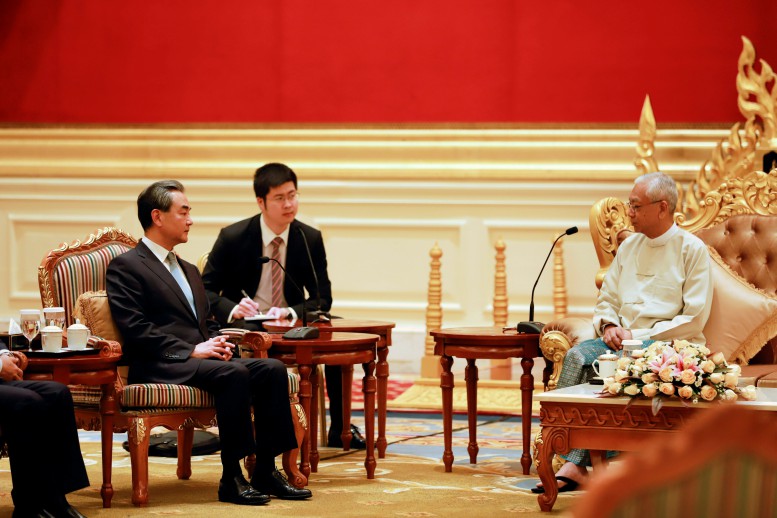China has proposed a three-phase plan for resolving the Rohingya crisis, starting with a ceasefire in Burma’s Rakhine State so that refugees can return from Bangladesh, China’s Foreign Ministry said ahead of meeting of European and Asian officials in Burma on Monday.
More than 600,000 Muslim Rohingya have fled to Bangladesh since late August driven out by a military clearance operation in Buddhist-majority Rakhine State.
The refugees’ suffering has caused an international outcry.
The foreign ministers’ Asia-Europe Meeting, or ASEM, opening in the Burmese capital Naypyidaw, is an important multilateral diplomatic gathering which happens once every two years and is designed to discuss issues between Asia and Europe. The meeting was scheduled to take place in Burma, officially known as Myanmar, before the outbreak of the current crisis.
Speaking in Naypyidaw on Sunday having arrived from Dhaka, China’s Foreign Minister Wang Yi said China believed that the Rohingya crisis could be addressed by a solution acceptable to neighbours Burma and Bangladesh through consultations. “The first phase it to effect a ceasefire on the ground, to return to stability and order, so the people can enjoy peace and no longer be forced to flee,” China’s foreign ministry said in a statement citing Wang.
“With the hard work of all sides, at present the first phase’s aim has already basically been achieved, and the key is to prevent a flare-up, especially that there is no rekindling the flames of war.”
After a ceasefire is seen to be working, Wang said bilateral dialogue should follow to find a workable solution, and the third and final phase should be to work toward a long-term solution based on poverty alleviation.
Wang said poverty was the root cause of the conflict.
Burma’s military has said that all fighting against the Rohingya Islamist militants died out on 5 September, but it remains on guard against incursions by fighters who had fled to Bangladesh with the refugees.
The refugee crisis erupted after the military launched a brutal counter-insurgency operations against the militants after attacks on an army base and dozens of police security posts in Rakhine on 25 August.
The group behind those attacks, Arakan Rohingya Salvation Army (ARSA), had declared a one-month ceasefire on 10 September, which was rejected by the government. But there have been no serious clashes since.
Visiting Burma last week, U.S. Secretary of State Rex Tillerson condemned ARSA’s attacks, and voiced support for Burma’s transition to democracy under the civilian administration led by Nobel Peace prize winner Aung San Suu Kyi. But Tillerson also called for a credible investigation into reports of human rights abuses against the Rohingya committed by Burma’s security forces, whose generals retain autonomy over defence, internal security and border issues.
Increased engagement
The United States and other Western countries have become more engaged with Burma in recent years, since it began a transition to civilian government after nearly 50 years of military rule.
Speaking on the sidelines of the ASEM meeting, European Union foreign policy chief, Federica Mogherini, said: “We believe that stopping the violence, the flow of refugees and guarantee full humanitarian access to the Rakhine State, and safe, sustainable repatriation of refugees are going to be key.”
Mogherini, who also visited Bangladesh over the weekend, said, “There’s a real possibility of Myanmar and Bangladesh reaching a memorandum of understanding and agreement for the safe repatriation of refugees to Myanmar.”
She said the European bloc was ready to help with the process.
Burmese state media said the meeting was being attended by senior officials of the ASEAN Secretariat, 28 member countries of the EU, two non-EU member countries, 10 member countries of ASEAN, 11 countries of Northeast and South Asia, totalling 51 countries.
China has close relations with both Burma and Bangladesh, and has long been a key player in lawless borderlands where rebel ethnic groups have fought Burma’s government for decades. The conflict in those border regions has occasionally pushed thousands of refugees to seek shelter in China.
[related]
Since the Rohingya crisis, China has repeatedly expressed support for what it calls the Burmese government’s efforts to protect stability.
Burmese and Bangladesh officials began talks last month to settle a repatriation process for refugees, and Bangladesh’s foreign minister expects to take those talks to the next level in coming days.
The international community and the United Nations Security Council should give encouragement and support to both countries “to create the necessary conditions and a good environment”, the ministry’s statement quoted Wang as saying at a joint press conference with Aung San Suu Kyi, Burma’s de facto leader.



